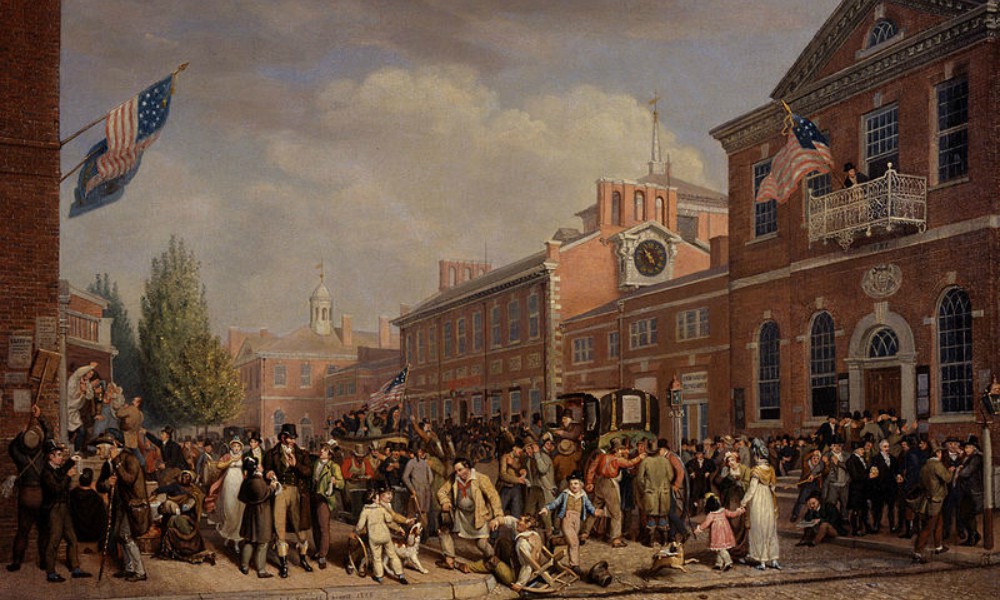Moment brings you essential independent reporting from the Jewish community and beyond. But we need your help. Your support is critical to the work we do; every tax-deductible gift, of any amount, keeps us going. Thank you for reading and thank you for your help. Donate here.
In May 2016, Moment published an “Ask the Rabbis” forum on the question: “Are we commanded to vote?” All of the rabbis argued that we should vote, but they grounded their answers in a multiplicity of reasons: Jeremiah’s injunction to join in building the community in which you live; an ancient preference for some degree of democracy in government; the principle of hakarat ha-tov, recognizing the good someone has done you; the consciousness that Jews could not vote until quite recently, either because they were Jews or because the societies in which they lived were not democracies. In fact, the latter reason was by far the common one in the 18th, 19th, and even 20th-century. The British colonies in North America were among the historical settings in which many Jews could not vote because they were Jews.
Before 1776, each American colony had its own, uniquely phrased law about voter qualifications. Typically, white men over the age of 21 who owned 50 acres of land might vote, but the details varied by colony and were often a bit murky. The property requirement might be higher or lower; ownership of a certain amount of personal property, or the payment of a certain amount in taxes, might suffice. Expectations about voters’ race and gender were not necessarily made explicit, and teenagers often voted in militia elections. Perhaps 10 to 20 percent of American colonists had the right of suffrage: a remarkable achievement in the 18th-century world, but pitifully low in comparison with the 21st century ideal of universal suffrage for adults.
The colonial governments did not have any real consensus on whether there should be religious qualifications for voting. At first, there were few, but that may have been because voters’ Protestant convictions, like their whiteness and maleness, were taken for granted. After the Glorious Revolution of 1688-1689 tied Protestantism to British identity, several colonies moved to bar Catholics from voting, and the new clauses were often phrased in a way that barred Jews as well. Colonies drew a sharp distinction between religious liberty—which they increasingly championed—and the right to participate in governing, which they often reserved for Protestants. The famously broad-minded colony of Pennsylvania restricted voting rights to those who accepted Jesus as their savior; Jews (and other non-Christian theists) had the right to settle and be naturalized, but not the right to vote. New York frequently did allow Jewish residents to vote, but their votes were sometimes challenged.
The American Revolution changed the landscape of voting rights to some degree. In essence, it created a new, federal layer of government, in which there was absolute freedom of religion—and no religious test that might prevent a Jew from serving in Congress or even as president—without removing the religious tests that existed in many individual states. Most of the states wrote new state constitutions in the 1770s, and some softened or removed their existing religious tests, but some did not. For example, South Carolina, Georgia and New Hampshire limited officeholding to men “professing a belief in the faith of any Protestant sect” (the language is from the New Hampshire Constitution of 1776). Thomas Jefferson’s famous Statute of Religious Freedom spoke only for Virginia.
The real work of abolishing religious tests for suffrage was done at the state level, largely in the half-century after the American Revolution. The United States’ Jewish population numbered no more than 2,500 souls at the outset, and the state-level religious tests were probably gestures designed more to cultivate shared Protestant or Christian identity than to exclude residents of other faiths. In the decades following the American Revolution, an era of particularly diverse and energetic religious engagement, public opinion gradually turned against these religious tests. Increasing Catholic and Jewish immigration to the U.S. in the middle decades of the 19th century created many non-Protestant U.S. citizens to benefit from the widening of suffrage. Still, the New Hampshire test, quoted above, remained in force until 1877. The history of Jewish voting rights in the United States is thus a tango of overt exclusion in the 18th century followed by a deliberate rewriting of restrictive laws in the 19th. But perhaps this is a blessing: We might find encouragement in a history that forced the American people to explicitly consider the question of religious tests for voting and deliberately decide to extend suffrage to people of all faiths.
Top photo: Wikimedia Commons Election Day in Philadelphia, also known as Election Scene. Statehouse in Philadelphia 1815 (1815) by John Lewis Krimmel (1787-1821), one of two similarly named paintings by the artist. Oil on canvas, 16 by 25 inches. Signed and dated. Held by the Winterthur Museum of Art

